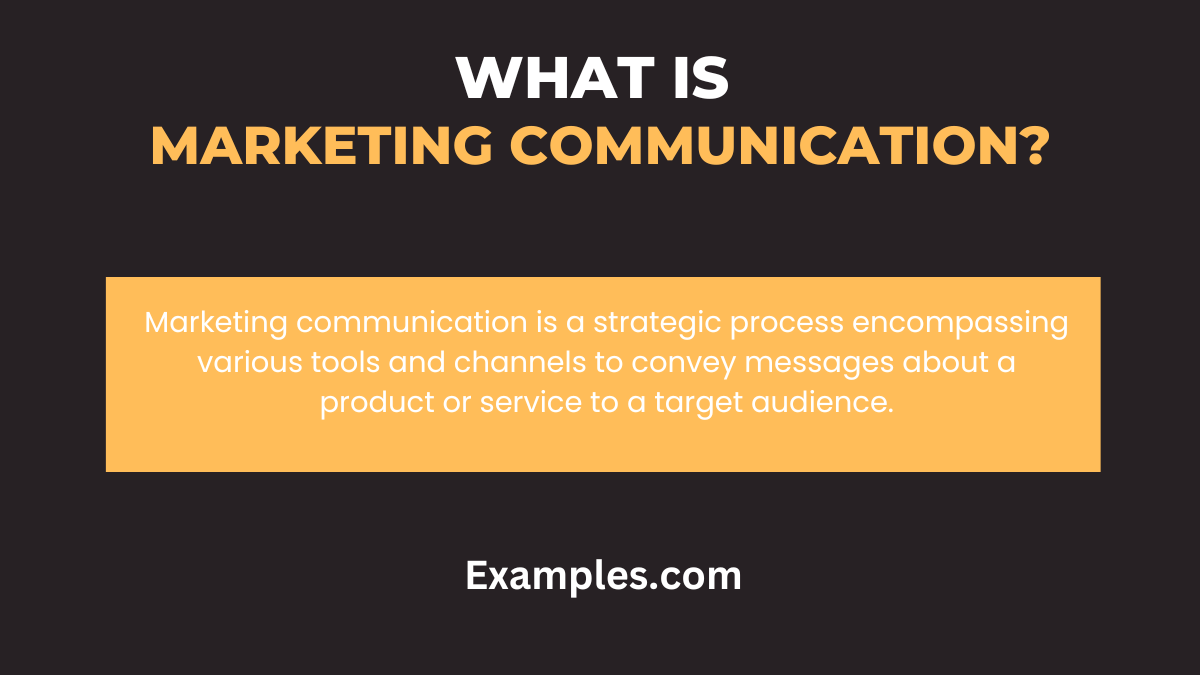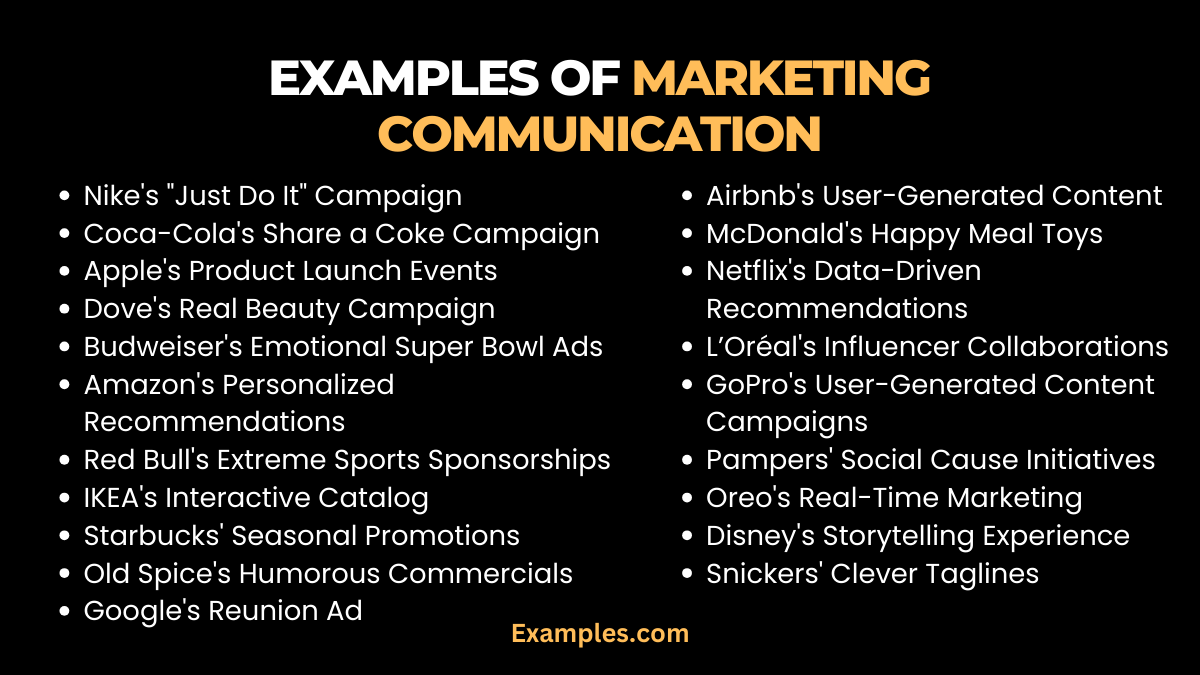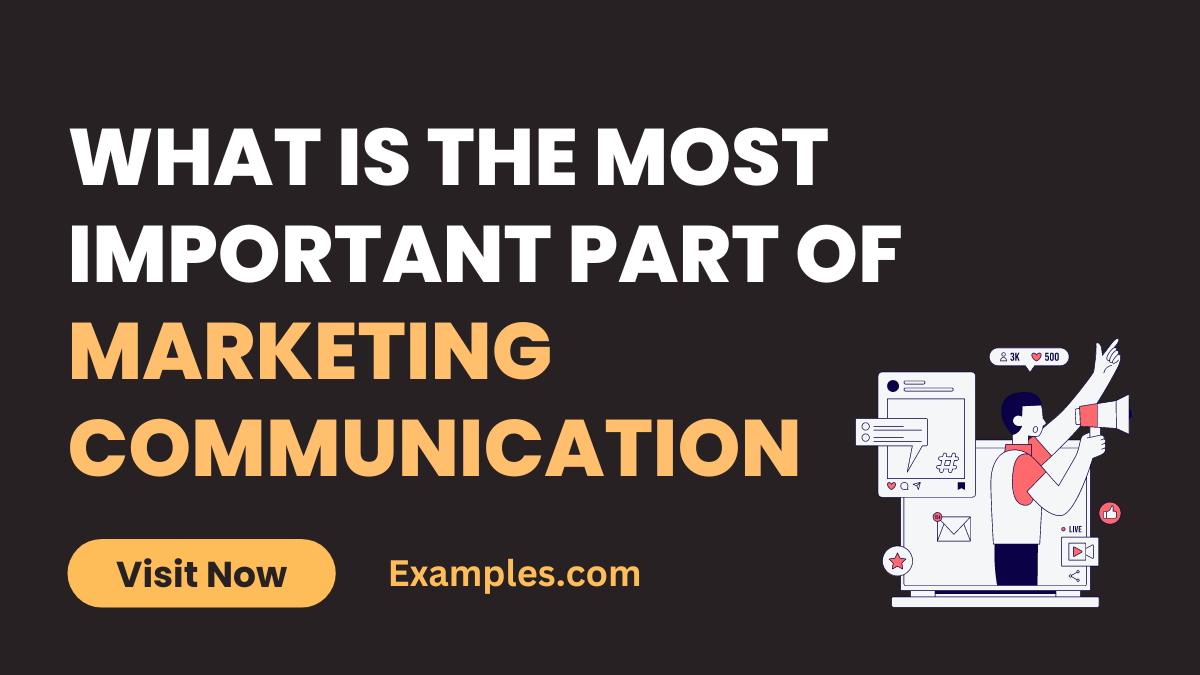19+ What is the Most Important Part of Marketing Communication Examples
Embark on a journey into the dynamic realm of Marketing Communication. Defined as the strategic exchange of messages, this pivotal practice has evolved through history, shaping consumer engagement. Explore the origins, absorb examples from renowned campaigns, and uncover the intricacies of effective marketing communication. This guide offers practical tips and a how-to approach, empowering you to master the art of compelling communication in the ever-evolving landscape of marketing.
What is Marketing Communication?

Marketing communication is a strategic process encompassing various tools and channels to convey messages about a product or service to a target audience. It involves the art of crafting compelling narratives, utilizing advertising, public relations, digital media, and other means to engage and influence consumers. The primary goal is to build brand awareness, foster positive perceptions, and drive desired actions, making marketing communication a cornerstone in achieving business objectives.
20 Examples of Marketing Communication

Marketing communication embodies diverse strategies aiming to engage audiences and promote brands. Each example illustrates the effective application of these strategies, showcasing the versatility of marketing communication tactics across various industries and platforms.
- Nike’s “Just Do It” Campaign: Emphasizes empowerment and motivation through concise, impactful messaging. How to communicate: Boldly inspire action, encouraging customers to embody a brand’s ethos.
- Coca-Cola’s Share a Coke Campaign: Personalizes products by printing names on bottles, enhancing consumer connection. How to communicate: Foster personalization to evoke a sense of belonging and engagement.
- Apple’s Product Launch Events: Utilizes hype and anticipation, creating buzz around new releases. How to communicate: Build anticipation by teasing upcoming launches, sparking curiosity.
- Dove’s Real Beauty Campaign: Focuses on inclusivity and body positivity, promoting authenticity. How to communicate: Highlight social causes to resonate with consumers’ values.
- Budweiser’s Emotional Super Bowl Ads: Evokes emotions through storytelling during major events. How to communicate: Craft narratives that tug at heartstrings, creating lasting impressions.
- Amazon’s Personalized Recommendations: Utilizes data-driven suggestions to enhance customer experience. How to communicate: Implement personalized recommendations based on user behavior.
- Red Bull’s Extreme Sports Sponsorships: Associates brand with adrenaline and excitement. How to communicate: Sponsor events that align with brand values to connect with target demographics.
- IKEA’s Interactive Catalog: Offers an engaging online catalog experience for customers. How to communicate: Create interactive content to captivate and educate audiences.
- Starbucks’ Seasonal Promotions: Introduces limited-time offerings, fostering a sense of urgency. How to communicate: Leverage exclusivity and scarcity to drive sales.
- Old Spice’s Humorous Commercials: Uses humor to engage and entertain audiences. How to communicate: Infuse humor strategically to leave a memorable impact.
- Google’s Reunion Ad: Portrays emotional narratives that resonate universally. How to communicate: Showcase emotional connections relevant to target audiences.
- Airbnb’s User-Generated Content: Leverages user stories and experiences to build trust. How to communicate: Encourage customers to share their brand experiences.
- McDonald’s Happy Meal Toys: Offers collectible toys to attract families and children. How to communicate: Utilize giveaways or incentives to attract specific customer segments.
- Netflix’s Data-Driven Recommendations: Provides personalized content suggestions based on viewing habits. How to communicate: Employ data to offer tailored recommendations.
- L’Oréal’s Influencer Collaborations: Partners with influencers for authentic product endorsements. How to communicate: Collaborate with influencers who align with brand values.
- GoPro’s User-Generated Content Campaigns: Encourages customers to share adventure footage. How to communicate: Foster user participation to amplify brand reach.
- Pampers’ Social Cause Initiatives: Engages in social responsibility campaigns supporting child welfare. How to communicate: Align brand values with social causes for impact.
- Oreo’s Real-Time Marketing: Reacts swiftly to cultural events, staying relevant. How to communicate: Stay agile and responsive in real-time marketing efforts.
- Disney’s Storytelling Experience: Immerses customers in magical narratives across all touchpoints. How to communicate: Create cohesive narratives across branding channels.
- Snickers’ Clever Taglines: Uses catchy phrases for instant recognition and recall. How to communicate: Craft memorable taglines that encapsulate brand essence.
Advertising in Integrated Marketing Communication
Advertising within IMC involves crafting persuasive messages to promote products or services. It leverages multiple channels like print, digital, TV, radio, and social media, aiming to influence consumer behavior and build brand visibility. Key aspects include:
- Message Consistency: Ensuring uniformity in messaging across all advertising platforms, aligning with the overall brand strategy.
- Targeted Approach: Tailoring advertising content to resonate with specific demographics or segments within the audience.
- Media Selection: Strategically choosing advertising platforms based on audience behavior and preferences to maximize impact.
- Creativity and Appeal: Employing creative and compelling content to capture audience attention and evoke desired responses.
- Measurement and Evaluation: Assessing advertising performance through metrics like reach, engagement, and conversions to optimize future campaigns.
Integrated Marketing Communication For Public Relations
In the dynamic landscape of integrated marketing communication (IMC), public relations (PR) plays a pivotal role. PR is a strategic communication process aimed at cultivating favorable relationships between an organization and its public. It involves managing perceptions, building credibility, and fostering goodwill. Here’s a comprehensive guide to integrating PR seamlessly into your communication strategy to amplify your brand presence.
- Understanding Public Relations in IMC: In IMC, PR is more than press releases; it’s about shaping the narrative around your brand. It involves proactive communication to enhance the overall image and reputation.
- Strategic Storytelling: Craft compelling narratives that resonate with your audience. PR within IMC revolves around telling stories that evoke emotions, build trust, and align with your brand values.
- Building Credibility through Media Relations: Leverage media channels strategically. Establish relationships with journalists, influencers, and industry leaders to secure positive coverage and enhance your brand’s credibility.
- Crisis Management and Communication: PR in IMC is crucial during crises. Develop a robust crisis communication plan to navigate challenges, maintain transparency, and protect your brand reputation.
- Aligning PR with Marketing Goals: Integrate PR efforts with broader marketing objectives. Ensure consistency in messaging across all channels to reinforce brand identity and support marketing
The Future of Marketing Communication
In an era marked by technological advancements and evolving consumer behaviors, the future of marketing communication holds exciting prospects. Here’s a comprehensive guide that explores the transformative trends shaping the landscape and how enhancing communication skills is crucial for staying ahead in this dynamic field.
- Understanding the Shifts in Consumer Behavior: The digital age has redefined how consumers engage with brands. Explore the nuances of consumer behavior changes, emphasizing the need for marketers to adapt their communication strategies.
- Emergence of Artificial Intelligence (AI) in Marketing Communication: Dive into the role of AI in revolutionizing marketing communication. From chatbots to personalized content recommendations, discover how AI is reshaping the way brands interact with their audience.
- Interactive Content and Immersive Experiences: The guide delves into the rising importance of interactive content, virtual reality, and augmented reality in marketing communication. Learn how creating immersive experiences can capture audience attention and enhance brand engagement.
- Importance of Data-Driven Decision-Making: In the data-centric landscape, understanding the significance of data-driven decision-making is paramount. Explore how leveraging data analytics can refine communication strategies, ensuring they resonate with target audiences.
- The Role of Social Media in Modern Communication: Social media continues to be a powerful force in marketing communication. Gain insights into the latest trends, algorithm changes, and effective strategies for utilizing social platforms to maximize brand reach.
- Building Authenticity and Trust: Authenticity is key in establishing trust with consumers. Uncover strategies for building an authentic brand image and fostering trust through transparent and genuine communication.
What Are Elements Of Marketing Communication
Marketing communication relies on several pivotal elements to effectively convey messages and engage with the target audience. Understanding these components is crucial for a successful marketing strategy:
- Advertising: A core component involving paid promotional messages through various media channels to reach and influence the audience.
- Public Relations (PR): Focused on managing the brand’s image through media relations, events, and communications to maintain a positive public perception.
- Sales Promotion: Utilizing incentives, discounts, or limited-time offers to stimulate immediate customer action.
- Direct Marketing: Engaging directly with customers through personalized messages via emails, texts, or direct mail to drive sales or brand engagement.
- Digital Marketing: Leveraging online platforms, including social media, websites, and SEO, to connect and interact with audiences effectively.
- Personal Selling: Involves direct communication between a sales representative and potential buyers to build relationships and address specific needs.
In the realm of marketing communication, the art lies in crafting compelling narratives and employing diverse strategies to captivate audiences. From the emotional resonance of Coca-Cola’s personalized bottles to the anticipation stirred by Apple’s product launches, these examples illustrate the dynamic landscape of marketing communication. Navigate this multifaceted guide for a comprehensive understanding of the elements and impactful executions that shape successful marketing communication strategies.



